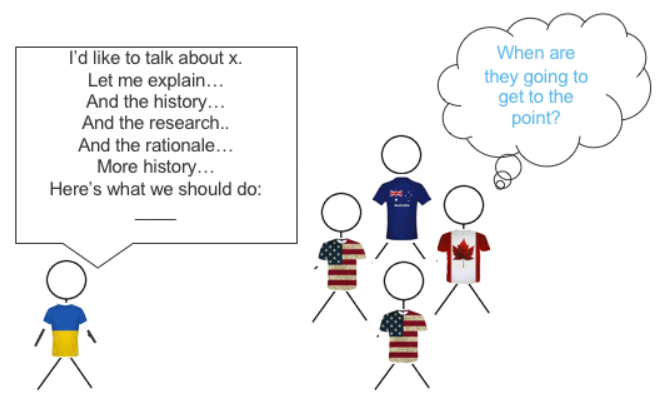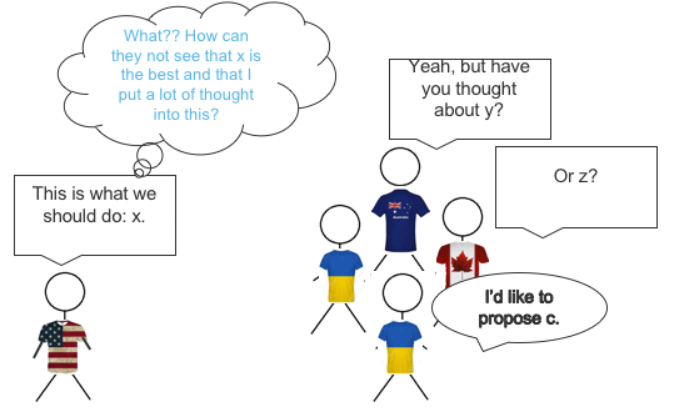Today, I’m going to continue my Growing Your Cultural Awareness in Business series, drawing on learnings from Erin Meyer’s The Culture Map. This post is the third in an eight-part series and will focus on the Persuading scale in the Culture Map (inductive vs. deductive persuasion).
Some of this content is either directly taken from, or is a summary of, Chapter 3 of The Culture Map, with my own examples and perspective added for clarity.
The Persuading Scale: Concept or Application First? … Why vs. How
Concept-First Reasoning (Deductive Reasoning):
- Individuals first develop a theory or concept before presenting facts, statements, or opinions.
- The focus is more on why than how.
- Theoretical arguments are built up before moving on to conclusions.
- Theoretical principals underlying an argument are valued.
- The argument begins with a thesis, or foundational argument. The communicator then shares the opposing view via some sort of antithesis. The two are then reconciled in a synthesis.
Application-First Reasoning (Inductive Reasoning):
- Individuals begin with facts, statements, or opinions and come back later to theory or concepts to help back up their conclusions, but only if necessary.
- The focus is more on how than why.
- The preference is to begin the message with an executive summary or quick bullet points.
- Theoretical or philosophical discussions are avoided in business settings.
- The argument begins with a general principle or proposal, then the communicator will provide any necessary facts, info, etc to back this up (as/if needed).
The above characteristics can show up in things like: how a person leads a meeting, how someone gives a presentation, and even how they will write emails or other communications.
For a breakdown of where SPS’s offices fall on the Persuading Scale (Concept-First vs. Application-First Reasoning), see below:

Note: Countries represented: UA = Ukraine, AU = Australia, CA = Canada, US = United States. These are the locations that I work most closely with, though we have team members in other global locations as well. It’s also important to remember that when thinking about different persuasion styles of your team members, it’s all relative. For example, even though Canada and the US are similar on the scale, Canadians would still see Americans as being ‘application-first’ and Americans would view Canadians as being ‘concept-first’ (because, compared with each other, these are both ‘true’).
Avoiding Confusion
Concept-First Culture → Application-First Culture

A note to my concept-first colleagues: Your application-first colleagues might stop paying attention if they think that you don’t have a point to make.
Strategies for Working with Application-First Cultures
If Speaking/Presenting To Application-First Cultures:
- Get to the point quickly and stick to it. You don’t have to start by building up your argument, counter-argument, etc.
- Provide practical examples up-front. Your audience will extract appropriate learning from the examples.
If Listening To Application-First Cultures: NOTE: ‘listening’ can mean actual listening or reading emails or other forms of consuming information
- Remember, just because your colleague jumped straight to the conclusion doesn’t mean they didn’t do thorough research or have strong supporting data for their conclusion/proposal/statement.
- Similar to the above, it’s always OK to ask questions. This can help provide some of the ‘why’ that you may be missing. However, if it seems that your application-first colleague gets defensive when you do so, they are maybe feeling like you are trying to make them look bad/cause them to fail. Let them know that you are just looking for their background, research, etc so that you can understand ‘the why behind the how’.
Application-First Culture → Concept-First Culture

A note to my application-first colleagues: Concept-first colleagues likely will be confused if you jump straight to your conclusion/proposal → What research or data do you have to support this? Where’s your ‘why’ to support the ‘how’?
Strategies for Working with Concept-First Cultures
If Speaking/Presenting To Concept-First Cultures:
- Spend more time than you normally would setting the parameters, explaining the background, doing thesis → antithesis → synthesis before you move to your conclusion, proposal, etc.
- Practical examples are appreciated, but the basis of the framework, methodology, reasoning, etc. should be explained thoroughly first.
- Remember, if your colleague is asking a lot of questions or is seemingly challenging your statement/proposal, it’s because this is normal for them (remember: thesis → antithesis → synthesis)
If Listening To concept-first cultures Again, listening is any form of consuming spoken or written communication.
- Don’t skip over the why at the front-end. Just because they haven’t gotten to the point quickly doesn’t mean that they won’t. In fact, they’re building up all of the reasons for the how and may preemptively answer any questions you may have.
- It’s always OK to ask questions or give conflicting arguments. This can help with building up the antithesis, which may be appreciated, if done well.
Holistic vs. Specific Thinking
You might be asking “Jon, you’ve included your Indian team on prior culture scales. What about India (or other Asian cultures) for the persuasion scale?” Great question! The above can be understood as specific thinking: This type of thinking is essentially that you can analyze individual things outside of their context in order to understand them better. Asian countries operate with holistic thinking: An individual (or individual thing) is impacted by its environment, and thus in order to understand that thing, you need to also take its environment into consideration. There are too many interdependencies to take one specific thing and assess that on its own (this applies to situations, problems, etc.). Holistic thinkers focus more on background/environmental factors in order to understand the issue/problem/thing better (rather than honing in on the specific issue itself). An easy way to understand this concept can be seen in the way that specific thinkers (especially ‘Westerners’) take pictures of people vs. how Asian cultures tend to take pictures of people: close-up on the individual vs. zoomed out to include the individual’s surroundings:

To read more about holistic vs. specific thinking, check out this article from Harvard Business Review.
In Closing
No matter who you are interacting with and what their cultural norm is, you will be most successful when you first seek to understand the other person and what their cultural norm is rather than assuming that they should understand, and adhere to, your cultural norm.
Want to Read More?
Curious to read more? Check out my other articles: Providing (Negative) Feedback Across Cultures, Communicating Effectively Across Cultures & The Benefits of Global Diversification. I’ll also be authoring articles on the remaining five scales of the Culture Map in the coming months, so keep your eyes out for those too!